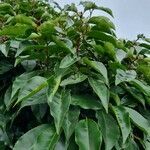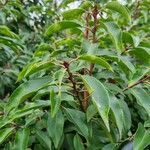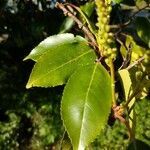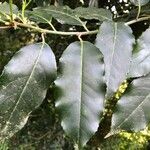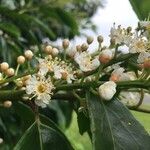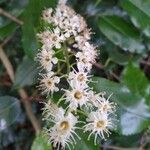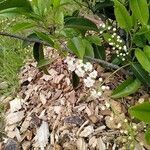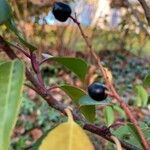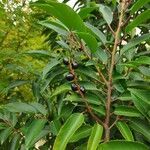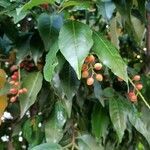Large, glabrous (except fls), evergreen shrub or small tree, not armed, to c. 7 m high (often to c. 12 m in cultivation); trunks usually several, often becoming fairly tall. Lf petiole 15-25 mm long; blade subcoriaceous, elliptic or elliptic-lanceolate, 70-140 × 25-60 mm, with a blunt cusp at apex, broadly cuneate or rounded at base, glossy above and below, with veins slightly impressed above, otherwise blade flat, crenate-serrate, entire near base; stipules linear-subulate, deciduous. Infl. a fairly dense raceme 23-30 cm long with 47-77 fls, terminal or in axils of upper lvs, erect or suberect; fls fragrant; pedicels 7-18 mm long, not elongating after anthesis but often turning red. Hypanthium broad; sepals broadly triangular, c. 1 mm long, obtuse, green, ± erect. Petals 5, spreading, orbicular, 3-5 mm diam., rounded, white. Stamens ± = petals; filaments white. Fr. 10-12 mm long, ovoid or broadly ovoid, smooth, glossy purplish black, very bitter; stone smooth except for marginal ribs.
More
A dense evergreen shrub. It grows 6-10 m high. It is a broad spreading shape. The bark is dark grey-brown and smooth. The leaves are alternate. The leaves are oval and 12 cm long by 5 cm wide and with red leaf stalks. The leaves are dark and glossy green above and yellow-green underneath. They have fine teeth and long pointed tips. The flowers are white and 1 cm across and in slender sprays. There are about 20 flowers in each cluster. These are about 25 cm long. The fruit are red and turn black as they ripen. They hang on stalks. There are 3 subspecies.
